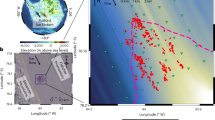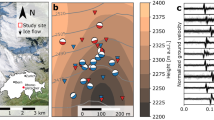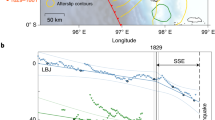Abstract
Between debris-laden glacial ice and bedrock, basal seismicity can develop that yields information about bed properties1,2, stress distribution3, outburst flooding4, and crevassing and calving5,6,7. Basal seismicity in response to glacial motion is linked to variations in both stress and lubrication of bedrock by water and till8,9. Here we analyse data from the Transantarctic Mountains Seismic Experiment array in 2002–2003 to investigate seismic behaviour at David Glacier, a large outlet glacier that drains 4% of East Antarctica’s ice sheet into the Ross Sea. We identify about 20,000 seismic events that are larger in magnitude and duration than typical for glacial sources and repeat at regular intervals of about 25 min. These events are consistent with stick–slip behaviour of debris-laden ice moving over a single obstacle of rough bedrock, modulated by relatively small stress changes from the ocean tides. In the years before and after the interval of repeating events, seismic events with irregular and generally longer intervals were detected at the same location, and are consistent with combined stick–slip and continuous sliding of the subglacial interface. We suggest that the observed transitions in seismicity patterns capture the dynamic behaviour of the ice stream, and that—despite lower ice-flow velocities—sliding in the stick–slip regime enhances subglacial erosion.
This is a preview of subscription content, access via your institution
Access options
Subscribe to this journal
Receive 12 print issues and online access
$259.00 per year
only $21.58 per issue
Buy this article
- Purchase on Springer Link
- Instant access to full article PDF
Prices may be subject to local taxes which are calculated during checkout



Similar content being viewed by others
References
Smith, A. M. Microearthquakes and subglacial conditions. Geophys. Res. Lett. 33, L24501 (2006).
Walker, R. T., Christianson, K., Parizek, B. R., Anandakrishnan, S. & Alley, R. B. A viscoelastic flowline model applied to tidal forcing of Bindschadler Ice Stream, West Antarctica. Earth Planet. Sci. Lett. 319–320, 128–132 (2012).
Anandakrishnan, S. & Bentley, C. Micro-earthquakes beneath Ice Streams B and C, West Antarctica: Observations and implications. J. Glaciol. 39, 455–462 (1993).
Winberry, J. P., Anandakrishnan, S. & Alley, R. B. Seismic observations of transient subglacial water-flow beneath MacAyeal Ice Stream, West Antarctica. J. Geophys. Res. 36, 1–5 (2009).
Ekstrom, G., Nettles, M. & Tsai, V. Seasonality and increasing frequency of Greenland glacial earthquakes. Science 311, 1756–1758 (2006).
Tsai, V., Rice, J. R. & Fahnestock, M. Possible mechanism for glacial earthquakes. J. Geophys. Res. 113, 1–17 (2008).
O’Neel, S., Larsen, C. F., Rupert, N. & Hansen, R. Iceberg calving as a primary source of regional-scale glacier-generated seismicity in the St. Elias Mountains, Alaska. J. Geophys. Res. 115, F04034 (2010).
Bindschadler, R., Stephenson, S., MacAyeal, D. & Shabtaie, S. Ice dynamics at the mouth of Ice Stream B, Antarctica. J. Geophys. Res. 92, 8885–8894 (1987).
Winberry, J. P. et al. Basal mechanics of ice steams: Insights from the stick-slip motion of Whillans Ice Stream, West Antarctica. J. Geophys. Res. 114, 1–11 (2009).
Rignot, E. Mass balance of East Antarctic glaciers and ice shelves from satellite data. Ann. Glaciol. 34, 217–227 (2002).
Frezzotti, M., Capra, A. & Vittuari, L. Comparison between glacier ice velocities inferred from GPS and sequential satellite images. Ann. Glaciol. 27, 54–60 (1998).
Frezzotti, M., Tabacco, I. & Zirizzotti, A. Ice discharge of eastern Dome C drainage area, Antarctica, determined from airborne radar survey and satellite image analysis. J. Glaciol. 46, 253–264 (2000).
Watson, T. et al. P and S velocity structure of the upper mantle beneath the Transantarctic Mountains, East Antarctic craton, and Ross Sea from travel time tomography. Geochem. Geophys. Geosyst. 7, 1–17 (2006).
Lawrence, J. F. et al. Upper mantle thermal variations beneath the Transantarctic Mountains inferred from teleseismic S-wave attenuation. J. Geophys. Res. 33, 1–4 (2006).
Chen, Y. & Sammis, C. Asperity models for earthquakes. Bull. Seismol. Soc. Am. 93, 1792–1802 (2003).
Sagy, A. & Brodsky, E. E. Geometric and rheological asperities in an exposed fault zone. J. Geophys. Res. 114, B02301 (2009).
Anandakrishnan, S. & Alley, R. B. Tidal forcing of basal seismicity of ice stream C, West Antarctica, observed far inland. J. Geophys. Res. 102, 15183–1596 (1997).
Anandakrishnan, S., Voigt, D. E., Alley, R. B. & King, M. A. Ice stream D flow speed is strongly modulated by the tide beneath the Ross Ice Shelf. J. Geophys. Res. 30, 1–4 (2003).
Bamber, J. L. & Bindschandler, R. A. An improved elevation dataset for climate and ice-sheet modeling: Validation with satellite imagery. Ann. Glaciol. 25, 438–444 (1997).
Danesi, S., Bannister, S. & Morelli, A. Repeating earthquakes from rupture of an asperity under an Antarctic outlet glacier. Earth Planet. Sci. Lett. 253, 151–158 (2007).
Pawlowicz, R., Beardsley, B. & Lentz, S. Classical tidal harmonic analysis including error estimates in MATLAB using T_TIDE. Comput. Geosci. 28, 929–937 (2002).
Brune, J. Tectonic stress and the spectra of seismic shear waves from earthquakes. J. Geophys. Res. 75, 4997–5009 (1970).
Walter, J. I., Brodsky, E. E., Tulaczyk, S., Schwartz, S. Y. & Pettersson, R. Transient slip events from near-field seismic and geodetic data on a glacier fault, Whillans Ice Plain, West Antarctica. J. Geophys. Res. 116, F01021 (2011).
Wiens, D. A., Anandakrishnan, S., Winberry, J. P. & King, M. A. Simultaneous teleseismic and geodetic observations of the stick–slip motion of an Antarctic ice stream. Nature 453, 770–774 (2008).
Hallet, B. A theoretical model of glacial abrasion. J. Glaciol. 23, 39–50 (1979).
Hallet, B. Glacial abrasion and sliding: Their dependence on the debris concentration in basal ice. Ann. Glaciol. 2, 23–28 (1981).
Iverson, N. et al. Soft-bed experiments beneath Engabreen, Norway: Regelation infiltration, basal slip and bed deformation. J. Glaciol. 53, 323–340 (2007).
Engelder, J. Microscopic wear grooves on slickensides: Indicators of paleoseismicity. J. Geophys. Res. 79, 4387–4392 (1974).
Iverson, N. Potential effects of subglacial water–pressure fluctuations on quarrying. J. Glaciol. 37, 27–36 (1991).
Hallet, B. Glacial quarrying: A simple rheoretical model. Ann. Glaciol. 22, 1–8 (1996).
Acknowledgements
Seismometers were supplied by PASSCAL. Seismic data were obtained from the DATA management Center of the Incorporated Research Institutions for Seismology. This research was financially supported by the Office of Polar Programs, US National Science Foundation (NSF 0424589). Partial support was provided by the US National Science Foundation through grants 0424589, 0538195, 0852697 and 9909603. We thank the TAMSEIS field and planning team for planning and carrying out the TAMSEIS field deployment.
Author information
Authors and Affiliations
Contributions
L.K.Z. located the seismic signals in the seismic records and carried out the seismic processing and modelling. All authors participated in the interpretation of the results and preparing the paper.
Corresponding author
Ethics declarations
Competing interests
The authors declare no competing financial interests.
Rights and permissions
About this article
Cite this article
Zoet, L., Anandakrishnan, S., Alley, R. et al. Motion of an Antarctic glacier by repeated tidally modulated earthquakes. Nature Geosci 5, 623–626 (2012). https://doi.org/10.1038/ngeo1555
Received:
Accepted:
Published:
Issue Date:
DOI: https://doi.org/10.1038/ngeo1555
This article is cited by
-
Highly variable friction and slip observed at Antarctic ice stream bed
Nature Geoscience (2023)
-
Evolution of aseismic slip rate along plate boundary faults before and after megathrust earthquakes
Communications Earth & Environment (2021)
-
Ocean-bottom and surface seismometers reveal continuous glacial tremor and slip
Nature Communications (2021)
-
Dynamic vulnerability revealed in the collapse of an Arctic tidewater glacier
Scientific Reports (2019)
-
Antarctic icequakes triggered by the 2010 Maule earthquake in Chile
Nature Geoscience (2014)



